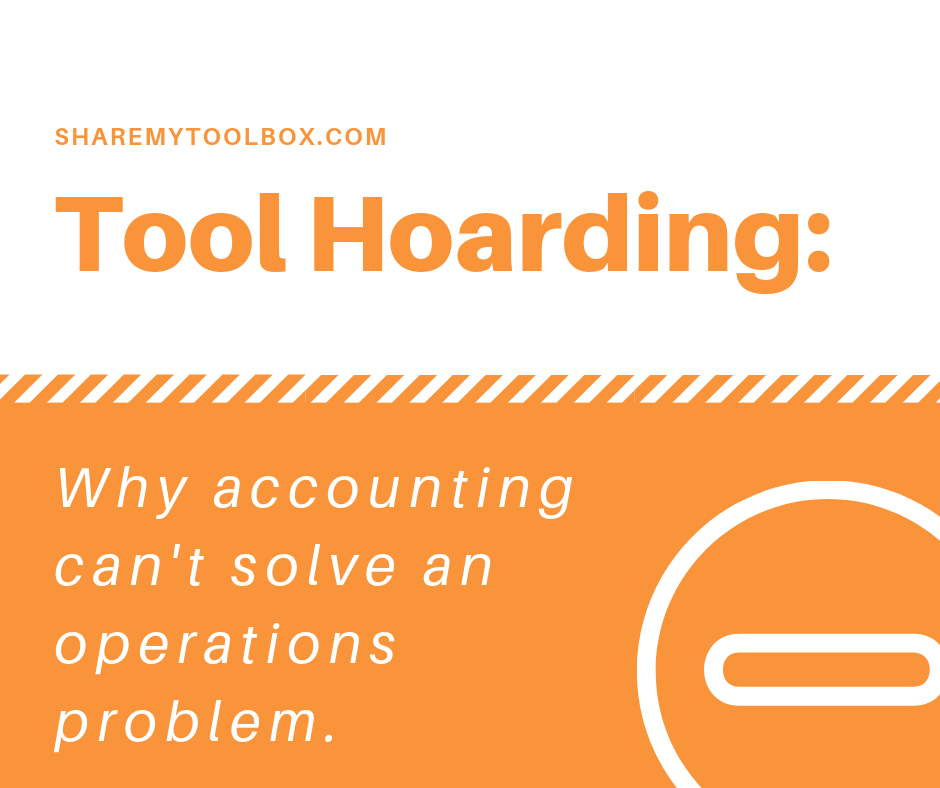Why are you using an accounting policy to solve an operation’s problem?
Let’s face it. Tool hoarding is a real problem.
Does this sound familiar? One of your projects has some important tools on site, so the tool manager holds on to them, arguing that they’re being used when actually they’re not. And since, in most cases, there’s no penalty for having unused tools on site, there’s no reason not to hoard! These tools end up sitting idle on the job site for days, weeks or months – un-billed and unaccounted for.
According to Modern Contractor Solutions, “More than $1 billion in valuable tools, commodities, and consumables are lost each year.” And to be clear, the definition of “lost” also includes tools that are secretly held and hidden on a jobsite (hoarded), causing a company to repurchase tools that aren’t truly lost.
It’s an operations problem
Unfortunately, many companies deal with tool hoarding – an operations problem – by trying to use accounting policies to get superintendents and project managers to “cough up the tools” and return them. This rarely works. In the end it is much more efficient to provide everyone with visibility to who has the tools and where those tools are located.
A great deal of accounting time in construction is spent administering and managing expensive time sheets. This requires a major time investment for employees to track their time and even more time for accounting employees who process the time and likely corrections. In fact, in an article in the Washington Business Journal, the American Payroll Association (APA) says “it takes five to six minutes to add and audit just one employees’ time card and manual time card computation errors can cost 1 to 8 percent of a company’s payroll!”
Interestingly, charging labor hours to jobs and charging small tools to jobs is essentially the same. You’re really just creating time sheets for tools! There’s a high organizational time cost of charging tools to jobs and this practice requires construction accountants to spend hours behind a desk connecting tool costing transactions to jobs, arguing with superintendents and changing transactions to correct inevitable mistakes.
Think about time sheets for tools this way – usage time has to be collected, then charged to jobs with mistakes corrected during and after processing. There is time required from superintendents plus time from office personnel to process, and then finally, time from management to review. But unlike payroll, this small tool time is a minor cost to the job and was truly only designed as a band-aid solution to reduce tool hoarding – which it fails miserably at doing!
If tool hoarding can be eliminated in a different, more efficient way, then tools can simply be costed to jobs as an automated allocation and all the costs to collect and process tool costs are eliminated. Let’s look at a better way of avoiding the pitfalls of tool hoarding.
Goodbye spreadsheets, hello tracking
With tool hoarding disrupting the flow of construction operations, contractors are looking at new ways to manage their tool inventories. With spreadsheets becoming too complex to manage and often riddled with errors, contractors are now investing in small tool management systems via “apps” downloaded on company smartphones and tablets.
An automated tool control system can remedy a labor shortage by allowing you to manage tools with fewer people, ultimately saving your company money by not having to replace lost or stolen items. With the ability to manage tool inventories remotely, construction companies can save significant time and money.
After deploying a tool tracking solution, you’ll be able to assign tool responsibility to individuals and make it easy to transfer responsibility when a tool moves from person to person while giving everyone in your organization the ability to easily search for tools and see who has what.
This eliminates the possibility of tools sitting idle – and could ultimately save your company some real money.
Learn More about How to Stop Tool Hoarding
If you’d like to learn more about modern tool tracking applications check out ShareMyToolbox or call, 866.768.8665.
Click here: to read How to start tracking tools.
See Tool Tracking Tips
Free and open access to articles, case studies and tool tracking best practices.
